Feral or wild hogs (Sus scrofa) have become free-ranging animals in some locations of the state, and their numbers continue to grow not only in Missouri but throughout portions of the Midwest, West Coast and Southeastern United States. Because of their destructive feeding habitats and potential to spread disease (including swine brucellosis, pseudorabies, trichinosis and leptospirosis), feral hogs are considered a substantial liability to agriculture and forestry production as well as to native wildlife. This guide has been developed to increase the understanding of feral hog biology and natural history and to provide information on damage management and control techniques.
Identification
A feral hog in Missouri is any swine that is born, living, or has lived in the wild, as well as the offspring of such swine.
Feral hogs can include Eurasian or “Russian” wild hogs and an assortment of hybrids (Yorkshire, Hampshire, Durocs and others) that have escaped into the wild or have been released for hunting purposes. Their size and color depend on their breed and the quality of nutrition during development. Feral hogs can reach a size of 3 feet in height, 5 feet in length and more than 400 pounds in weight. However, most sows will average about 110 pounds and boars will weigh an average of 130 pounds.
Eurasian wild hogs
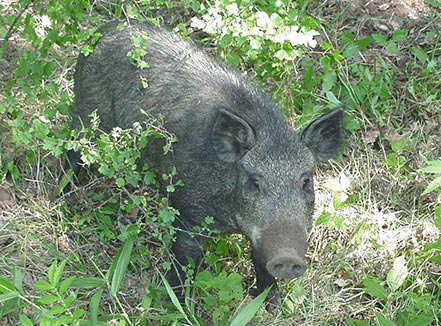
Pure strain Eurasian or Russian boars (referring to both sexes) differ in appearance from other types of hogs. These hogs usually have longer legs, a larger head and a longer snout. They also have four continuously growing tusks, longer hair with multiple splits at the ends of the hair shafts, and a mane from the neck to the base of their straight tail. Eurasian/Russian bred piglets are reddish brown with black longitudinal stripes. As the piglets mature, the stripes disappear and their color changes to mostly black (Figure 1).
Hybrids
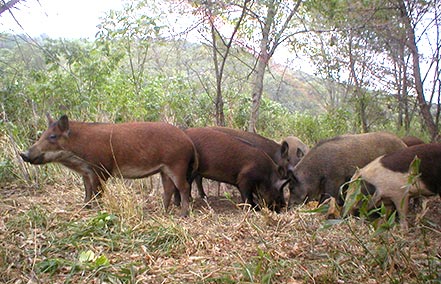
The majority of the feral hog population in Missouri consists of hybrids, which have genetic combinations that include Eurasian wild hogs along with an assortment of domestic varieties. These hybrids can look similar to domestic pigs, although most have the traditional wild boar appearance. All will have the small eyes, large triangular ears and a long snout ending in a large, round nose. Most of these hogs will have longer bristles than their domestic ancestors had, but shorter hair than that of purebred Russian boars. The resulting offspring exhibit a wide variety of shapes, patterns and colors, which can include gray, black, blond, spotted, belted and many shades and variations of these colors (Figure 2).
Distribution
Explorers from Europe introduced hogs into the Americas during the 15th and 16th centuries. They were then introduced into Florida in 1593 and free-ranging populations spread into the southeast United States as well as other locations across the country during the next few hundred years.
In Missouri, feral hogs have been roaming the countryside in the southern part of the state since the days of open range. These populations were isolated and kept in check by area farmers and local hunting efforts.
Populations began to increase and spread throughout the wider range during the 1990s, when recreational hog hunting began to gain popularity. Some individuals started raising European wild boars as a form of alternative agriculture and for hunting on licensed shooting areas. It was not long before some of these hogs escaped or were intentionally released on public and private lands.
Feral hog populations are now established in more than 20 southern Missouri counties, and most feral hog sightings occur in the southern third of the state (Figure 3). In general, feral hog numbers are relatively small and thinly scattered across the state. However, larger populations can be found on public and private lands in the Ozark and east-central regions.
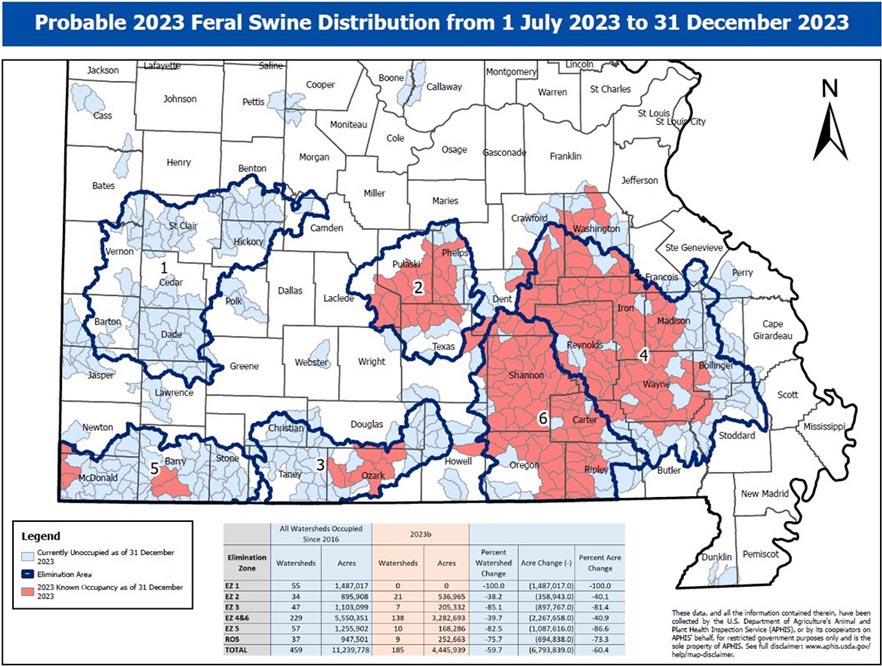
Biology and life history
Feral hogs have the capacity to breed at any time of the year when abundant food supplies are available. Sows can begin breeding at six months of age and can potentially produce up to two litters of four to 10 piglets every 12 to 15 months. With this high breeding potential, the population can double in about four months.
Feral hogs are also very social animals and tend to travel in family groups called sounders consisting of several sows and their offspring. Weaned pigs usually stay with their mother until another litter is born or until they mate. Adult boars are usually solitary, joining the group only to mate or to use a food source.
The home range for feral hogs varies in size and usually depends on the availability of food, water and cover. Where food is abundant, hogs occupy a smaller area than where food is scarce. Feral hogs, particularly boars, have been known to have a home range of more than 15 square miles when food is limited. A sow’s home range is much smaller and may cover 2 to 5 square miles, depending on habitat quality.
Feral hogs are highly adaptable. They can use nearly every type of habitat, but they prefer moist bottomland forests and areas around streams and creeks where mud for wallowing and foods such as acorns are plentiful. These brushy areas provide the dense vegetation that feral hogs need for cover. During the summer months, feral hogs are most active at night. During cooler seasons, they will be most active in early morning or late afternoon.
Feral hogs are omnivorous, which means they will eat almost anything from grain to carrion. The largest portion of their diet includes vegetable matter — and when available, acorns are a preferred food item. They have a strong sense of smell, which they use to locate food items. They will consume roots, eggs of ground-nesting birds, and invertebrates such as centipedes, leeches, earthworms and crayfish. In agricultural areas, they will consume cultivated crops. Wild hogs will also prey on young native wildlife, livestock and other small vertebrates.
Feral hogs live four to five years on average and have been known to live up to eight years. Mortality factors include disease, hunting, and predation from coyotes, bobcats and feral dogs. Adult feral hogs have no natural predators in Missouri.
Origin of Missouri’s feral hogs
A commonly asked question is where do the feral hogs in Missouri come from? Based on data from hogs eliminated across the state, over 99% of the feral swine sampled in Missouri are domestic pig/wild boar hybrids, which genetically differentiates these animals from domestic pigs. This translates to a highly adaptable animal with the reproductive capabilities of commercial breeds, a devastating combination that has led to a highly successful invasive animal.
Over 1,700 feral swine genetic samples have been processed from Missouri since 2016 by the USDA National Wildlife Research Center. From this information it is estimated that 1 out of 11 pigs have been released into the state, which means that over 90% of the feral hogs in Missouri come from already established populations that originated from neighboring states.
Sign of hogs’ presence
Feral hogs can root around and literally plow up soil to depths of 2 to 8 inches searching for favorite food items. A group of hogs can damage several acres in a short period of time. Because hogs do not sweat, they typically will cool themselves in “hog wallows”, muddy areas near seeps, springs, ponds and streams. Here they will leave their tracks and the imprint of their coarse hair in the mud. After wallowing, they will rub on trees, leaving mud and hair on the bark.
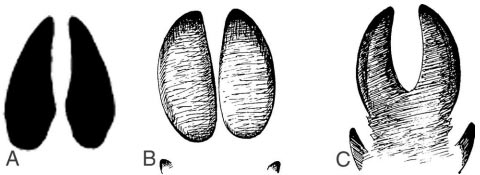
The scat of a feral hog looks like the pellets of deer feces; however, the pellets are larger and more variable in shape and content. Hog scat can contain grain, acorns, and the hair or feathers of whatever they have eaten.
Tracks of feral hogs are similar to those of deer — but with rounded toes. Hog tracks are also wider than they are long (Figure 4).
Damage
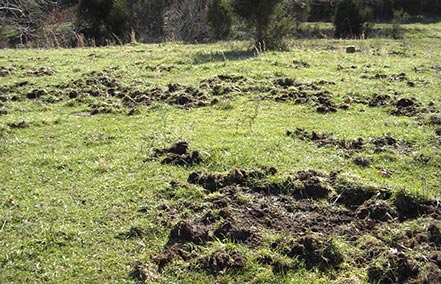
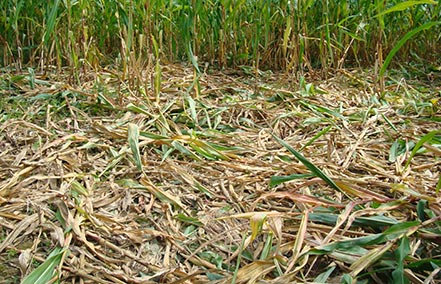
The presence of feral hogs, along with their rooting and feeding behavior, can cause severe damage not only to native wildlife and plant communities but also to agriculture (Figure 5). The USDA estimates that feral hogs cause $2.4 billion in agricultural damage and control efforts every year in the United States.
Agricultural damage by feral hogs is a major concern for producers. Feral hogs can wreak havoc on crop plants and pastures, leading to significant losses in agricultural operations.
Feral hogs are a threat to ground-nesting birds, including bob-white quail and wild turkey in Missouri. They will readily consume the eggs of ground-nesting birds, and in one study in Texas, it was estimated that feral hogs led to a 30% increase in nest depredation of turkeys, resulting in an additive effect with native nest depredators.
Feral hogs also compete with native wildlife for food resources. Feral hogs will consume many of the same foods as white-tailed deer, and it can be presumed that such competition impacts population sizes.
Foraging behavior by feral hogs consists of rooting, or use of the snout to dig and disturb soil and leaf litter. Such disturbance accelerates litter breakdown and elevates nitrogen in the soil, which has the potential to impact plant community composition. In studies where feral hogs were experimentally excluded from areas in a forest, the composition of plant communities varied from disturbed areas, with large seeded species such as oaks and hickories benefiting from hog exclusion. This suggests that over time, feral hogs can impact the prevalence of certain tree species in a forest.
Feral hogs also impact aquatic systems in an environment. Wallowing behavior by feral hogs can erode stream beds and pond banks, can increase turbidity and can decrease water quality. These factors impact native species of fish and amphibians, the latter being vulnerable to predation by feral hogs as well. Sensitive species of aquatic plants are also negatively impacted and can be outcompeted by invasive species that are given opportunity to invade by the disturbance created by feral hogs.
Parasites and diseases
Feral hogs have been documented to carry at least 30 diseases and over 40 parasites in the United States. The most concerning of these for people and livestock operators include brucellosis, pseudorabies, tularemia and leptospirosis. Many of these diseases have the potential to spread to cattle and domestic swine, as well as pets. Of significant concern in the United States is African Swine Fever. Although it has not yet been documented in populations in the United States, it has the potential to spread from nearby countries that have experienced outbreak in recent years, including Haiti and the Dominican Republic. African swine fever would wreak havoc on the domestic swine industry in the U.S.
Control
Feral hogs can be controlled by a variety of techniques, including trapping and targeted shooting by trained staff. There are currently no toxicants or repellents registered for the control of hogs in the state of Missouri. In Missouri, the Missouri Feral Hog Elimination Partnership (MFHEP) is a multi-agency and stakeholder partnership that works to remove feral hogs from the landscape. Working with landowners at no cost, the MFHEP conducts trapping aerial operations and utilizes drones to find and eliminate hogs (Figure 6).
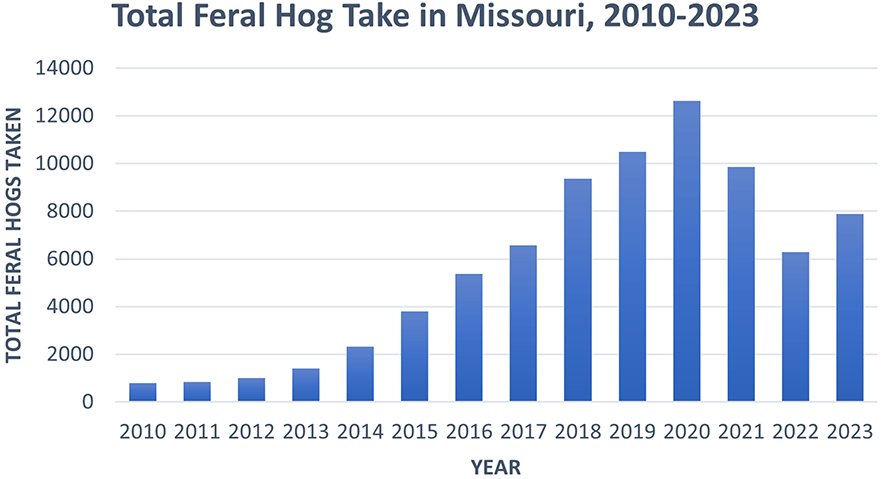
Trapping
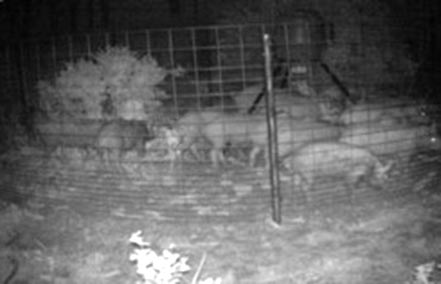
Trapping is the most common and effective method for catching and eliminating hogs. By using drop traps, multiple hogs can be caught at one time. Many cage trap designs have been used successfully. However, research at Texas A&M University has shown that to catch the most hogs at one time, larger traps are more effective than smaller box traps, which can only hold a few hogs and may be avoided altogether by “trap-wise” hogs (Figure 7).
Additional information on trapping feral hogs can be obtained from the Missouri Department of Conservation and from the resources provided in this publication.
Shooting
If you encounter a feral hog while hunting deer or other game, it is legal to shoot it on sight so long as you have a valid hunting license and unfilled turkey or deer tag. Feral hogs may be taken in any number throughout the year on private property. There are no public land hunting opportunities open to feral hog hunting except during deer and turkey seasons. Feral hogs may be taken during deer or turkey hunting season with a valid, unfilled permit on public property.
Hunting is not recommended for controlling feral hog populations. Hunting often results in scattering individual animals and prevents other control measures, such as trapping, from being effective.
Instead of hunting hogs to help reduce their numbers, individuals and hunters should report feral hog sightings to their local Missouri Department of Conservation agent. They can best determine how to capture and kill entire groups of feral hogs that are in the area.
Aerial operations
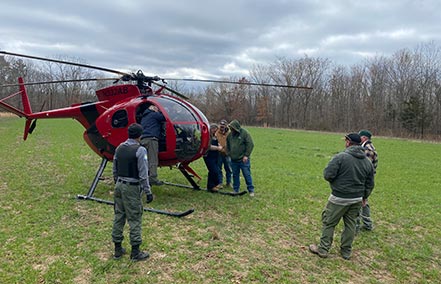
Aerial gunning utilizing helicopters (Figure 8) can be extremely effective in controlling feral swine due to the ability to eliminate groups quickly over vast areas. It is also very effective in detecting individuals that have learned to avoid other means of detection/removal or live within secluded areas in rough, hard to access terrain.
Aerial operations are a winter activity and take place between November and March. This is when aerial operations have the best visibility due to leaf shed. Over a quarter of the feral hogs removed in 2022 by the MFHEP were taken through aerial operations.
Drones
The state of Missouri is leading the nation in innovation, utilizing helicopters in conjunction with UAS (unmanned aircraft systems, or drones) and staff trained for night operations in the state. This technology has been instrumental in increasing the efficiency of scouting operations, night removals, targeting of lone boars, and increasing overall aerial operations efficiency.
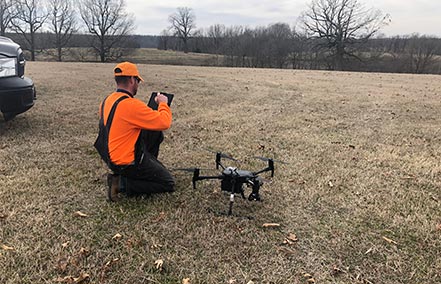
Small drones are flown during the daytime or at night with thermal sensors to detect feral swine across the landscape (Figure 9). Drones help cover more acreage, scouting and locating individuals to increase the efficiency and safety of the manned aircraft.
Summary
Feral hogs cause a wide variety of problems and can be a serious concern for private landowners as well as fish and wildlife managers. They are destructive to sensitive natural areas such as glades, fens and springs. Their tendency to wallow in wet areas can destroy these important habitats. The rooting and feeding behavior of feral hogs also contributes to soil erosion and reduces water quality.
In addition, feral hogs can cause significant damage to agriculture, including row crops and pastures. However, one of the biggest threats to agriculture is the potential transfer of disease from infected feral hogs to domestic swine herds. Feral hogs are known to carry swine brucellosis and pseudorabies. Both of these diseases cause abortions in sows and high mortality in piglets, which would be devastating in a domestic swine herd.
Missouri’s domestic swine are considered free of the above diseases and are a good source of safe, healthy pork products. However, an outbreak of swine brucellosis or pseudorabies from feral hogs into domestic swine could cripple Missouri’s pork industry, creating a negative economic impact that would affect the entire state.
Technical and educational assistance available
Many public agencies, including the Missouri Departments of Conservation and Natural Resources, the U.S. Forest Service and the U.S. Army Corps of Engineers, are actively eliminating feral hogs on their respective public properties as well as on the properties of adjoining landowners. The U.S. Department of Agriculture/Animal and Plant Health Inspection Service — Wildlife Services, also assists private landowners to eliminate hogs. Together, these organizations form the Missouri Feral Hog Elimination Partnership, and they work in tandem. Elimination specialists and outreach educators (Figure 10) collaborate across organizations to bring educational resources and provide technical assistance to landowners and the general public.
Report sightings of feral hogs and obtain additional information by contacting the USDA APHIS Wildlife Services at 573-449-3033 ext. 13; the Missouri Department of Conservation at 573-522-4115 ext. 3296.
Report the illegal release of feral hogs to the Missouri Department of Conservation’s Operation Game Thief Hotline at 800-392-1111. You may remain anonymous, and a reward is possible.
Photo credits: USDA APHIS-Wildlife Services